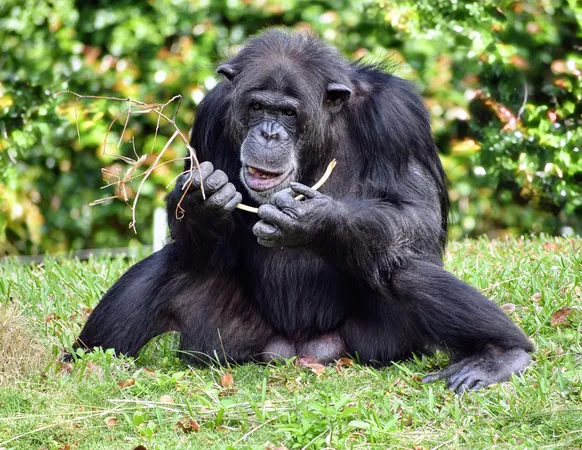
Chimpanzees Outshine Human Engineers With Advanced Tool-Making Skills!
2025-03-25
Author: Chun
Chimpanzees' Ingenious Tool-Making Skills
In the lush forests of Tanzania, chimpanzees have demonstrated remarkable ingenuity, crafting complex tools from local flora to fish for termites. This behavior, known for its sophistication, has captivated scientists for years. New groundbreaking research reveals that these primates don't just pick any old stick; they meticulously select materials based on their flexibility and effectiveness.
Research Collaboration
A team of researchers from prestigious institutions, including the University of Oxford, the Max Planck Institute for Evolutionary Anthropology, and the Jane Goodall Institute, collaborated on this illuminating study. Their findings offer valuable insights into the cognitive abilities of chimpanzees, shedding light on an often-overlooked aspect of primate evolution.
The Process of Termite Fishing
The process of termite fishing requires skill and precision; chimpanzees use slender plant probes to extract termites from convoluted tunnels within the nests. The researchers theorized that flexibility in tools would enhance accessibility to these hard-to-reach insects. To validate this, lead researcher Alejandra Pascual-Garrido performed tests at Gombe Stream National Park to measure the bending force of various plant materials.
Remarkable Findings
The results were incredible: the tools favored by the chimpanzees were significantly more flexible than the available alternatives. In fact, unused plant materials were, on average, a staggering 175% more rigid. Even among plants growing in proximity to termite mounds, those regularly selected by the chimpanzees exhibited much better flexibility.
Cognitive Insights
"This is the first comprehensive evidence that wild chimpanzees choose their tool materials based on specific mechanical properties," stated Pascual-Garrido, who has dedicated over ten years to studying chimpanzee tool-making.
Cultural Transmission
Notably, the chimpanzees at Gombe also share preferences with other chimpanzee populations across Africa, suggesting an impressive level of cultural transmission. The same plant species, such as Grewia, are employed by chimpanzees thousands of kilometers apart, indicating that these mechanical traits have become common knowledge among different groups.
Hypothesis of Folk Physics
This leads us to an intriguing hypothesis: chimpanzees may possess a form of "folk physics," an intuitive understanding of material properties that informs their choices. Their remarkable selection process transcends mere trial and error; it reflects a level of skill that might resemble the thought processes of our early human ancestors when crafting tools.
Implications for Human Evolution
The implications of this discovery extend far beyond chimpanzees, hinting at the evolutionary trajectory of tool-making in humans. "While materials like wood seldom survive in the archaeological record, the principles of effective tool-making remain constant, indicating a shared intelligence across species and eras," explained Adam van Casteren from the Max Planck Institute.
Learning Process in Chimpanzees
Additionally, this research raises important questions about the learning process among young chimpanzees. How do they acquire knowledge of tool selection? Is this skill passed down through generations, primarily through maternal teaching? Furthermore, do these intelligent apes apply similar reasoning when selecting tools for other purposes, such as ant or honey gathering?
Unlocking Clues About Human Intelligence
Studying the evolution of chimpanzee tool-making not only provides insight into their behavior but could also unlock clues about the origins of human intelligence. Understanding how these animals refine their techniques over time could illuminate a primitive form of trial-and-error learning, analogous to early human problem-solving strategies.
Conclusion
Ultimately, these extraordinary findings push us closer to unraveling the roots of human cognition through the lenses of our closest living relatives. This delicate balance between curiosity and cognitive ability showcases the beauty of evolution, bridging the gap between man and chimpanzee.
The full study is available for further reading in the journal *iScience*. Don't miss out on future discoveries—keep following our coverage for the latest updates on primate behavior and cognitive research!


 Brasil (PT)
Brasil (PT)
 Canada (EN)
Canada (EN)
 Chile (ES)
Chile (ES)
 Česko (CS)
Česko (CS)
 대한민국 (KO)
대한민국 (KO)
 España (ES)
España (ES)
 France (FR)
France (FR)
 Hong Kong (EN)
Hong Kong (EN)
 Italia (IT)
Italia (IT)
 日本 (JA)
日本 (JA)
 Magyarország (HU)
Magyarország (HU)
 Norge (NO)
Norge (NO)
 Polska (PL)
Polska (PL)
 Schweiz (DE)
Schweiz (DE)
 Singapore (EN)
Singapore (EN)
 Sverige (SV)
Sverige (SV)
 Suomi (FI)
Suomi (FI)
 Türkiye (TR)
Türkiye (TR)
 الإمارات العربية المتحدة (AR)
الإمارات العربية المتحدة (AR)